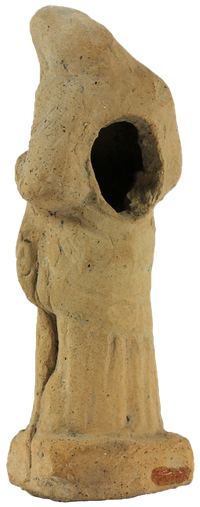Actor of the new comedy
Description: A figure in chiton and cloak stands on a flat, rectangular base. The long robe reaches with its dense, unevenly wide folds to the floor and to the tips of the shoes. The cloak covers the head and the bulge above the forehead, frames the face and veils the bent arms. Below the flat chest, the fabric forms a transverse bulge that ends in a triangular tip weighed down by a weight. The left hand grasps the free end of the cloak, which reaches down in longitudinal folds to the hem that slopes slightly to the right at the level of the knees. The open right hand points upwards with outstretched fingers and splayed thumb.
The head is tilted forward and to the left. Like the raised right shoulder, it shows a pronounced curvature towards the back, which is particularly evident in the side view. Small eyes with plastically protruding upper lids lie deep in their sockets. The brows rise steeply beside the root of the nose, but then form shallow arches. The powerful, triangular chin, the smooth cheeks and the large half-open mouth determine the lower face, whose dominance over the low, domed forehead is further emphasised by the fracture. The slight asymmetry in the area of the eyes and cheeks was probably caused by the removal from the mould.
Commentary: The statuette probably depends on the same matrix as a specimen in Berlin[1] from Capua[2]. As a respectable woman, she carefully veils herself as soon as she leaves the house. Only her hands are uncovered enough to accompany her lively speech with appropriate gestures[3]. The large broadly drawn, half-open mouth, the flat chest and the hump-like raised right shoulder give the impression of an ugly old woman[4]. Not only the exaggerated features, but also the considerable distance between the nose and the back of the head suggest that a mask is being worn.
The legs, apart from the tips of the shoes, are hidden behind vertical folds of chiton[5]. The horizontal cloak bulge indicated relatively high up and the hanging fabric below the left arm correspond to a garment draping that has appeared on male and female figures since the advanced 4th century BC[6]. The cloak motif is similar to that of the seated old woman on Dioskourides' mosaic from Pompeii[7]. Here, however, bulging strands emerge from under the cloth covering the head, whereas no forehead hair can be delineated in the Giessen statuette.
Determination: 300 BC, from Capua.
 |
 |
 |
|---|
[1] Bürgerwelten. Hellenistische Tonfiguren und Nachschöpfungen im 19. Jh. Staatliche Museen zu Berlin (Mainz 1994) 138 f. fig. 68; M. Bieber, The History of the Greek and Roman Theater (Princeton 21961) 97, fig. 353; A. Pickard-Cambridge, The Dramatic Festivals of Athens (Oxford 31988) 229 fig. 131; L Webster, Monuments Illustrating New Comedy (London 21969); Winter 1903 2, 428, 2.
[2] Perhaps it is Myrrhina, a rich Corinthian matron from Menander's comedy Perikeiromene, Bieber ibid. 1961, 97 fig. 353; Pickard - Cambridge 31988, 228 f. no. 6, fig. 131; Webster 21969, 127, NT 12.
[3] Bieber 1961, 97.
[4] S. Pfisterer-Haas, Darstellungen alter Frauen in der griechischen Kunst (Frankfurt am Main 1989) 85, note 319.
[5] G. Kleiner, Tanagrafiguren (Berlin 1942) 105.
[6] G. M. A. Richter, The Portraits of the Greeks (Oxford 1984) 42 f. fig. 9.a. S. 46 f. fig. 10. p. 203 fig. 164; without kolpos, M. Meyer, Die griechischen Urkundenreliefs (Würzburg 1989) 309 A 156 pl. 49, 2.
[7] Here the bulge above the forehead is clearly hair, s. St. De Caro (ed.), Il Museo Archeologico Nazionale di Napoli (Neapel 1994) 141 no. 9987.

